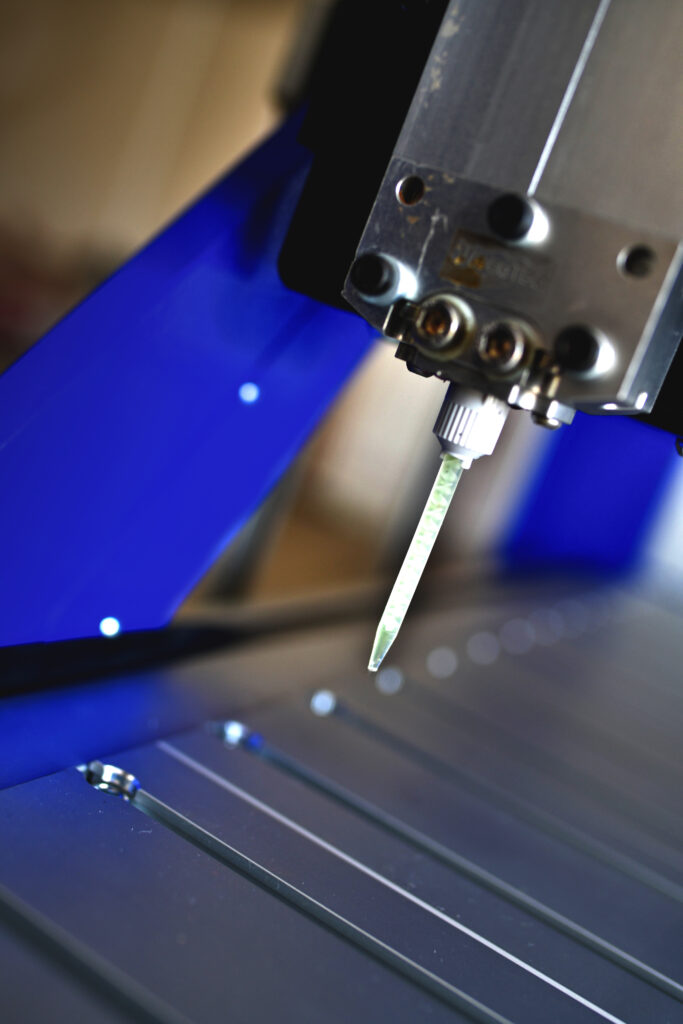Historically, 3D printing has struggled to create durable and functional elastomeric components. However, recent advances in material science are beginning to change that. The use of material fusion TPU on desktop printers, as well as PP and TPU in powder bed fusion, has ushered in enhanced performance capabilities. One startup making significant strides in this area is Minnesota-based Chromatic 3D Materials. The company employs a unique approach using two-part thermoset elastomers in a mixing head, which are then activated through reactive chemistry. These materials are blended, cross-linked, and then extruded to form strong components that are both watertight and airtight, thanks to the use of polyurethane.
Creating airtight components has traditionally been a challenge in the 3D printing sector. For years, attempts have been made to fabricate cushions, bellows, and other airtight elastomeric parts with varying degrees of success. Now, Chromatic 3D Materials is partnering with Austria’s national railway, ÖBB, to address this very issue. The collaboration focuses on developing grommets, cable glands, valve covers, and bellows.
ÖBB’s specialized unit, ÖBB Train Tech, had been grappling with the challenge of producing out-of-production components and enlisted Chromatic’s expertise to create 130 such parts. These components needed to form secure seals, often to minimize moisture absorption, fouling, and leakage. Some of the grommets were even designed to bear loads, adding another layer of complexity to the project.
“We chose Chromatic because they are able to print PU in different hardness between 50-90 shore A,” said Sebastian Otto, Head of AM at ÖBB Train Tech.
Dr. Bart Engeldahl, Managing Director of Chromatic 3D Materials in Germany said, “At Chromatic, we take pride in the durability of our 3D-printed materials, which have undergone rigorous testing. Now that ÖBB is demonstrating the use of our 3D materials in rail applications, we expect customers with demanding transportation, aerospace, industrial and defense applications will have confidence in Chromatic’s products and printing technologies,”
I find this development truly exciting. Flexible components like valves and grommets are ubiquitous, and a subset of these are critically important, out of production, and difficult to replace. While this might seem like a niche, the sheer volume of such components in use means that it can translate into a significant business opportunity for the additive manufacturing sector. Adding to this, rail companies are coordinating through Mobility goes Additive to leverage 3D printing for maintenance, repair, and operations (MRO). If ÖBB finds success with these parts, the knowledge will likely be disseminated to other national railways.
It’s crucial to note that rail companies have their own stringent quality and safety standards, which can be challenging to meet. Chromatic has addressed this, particularly in the area of flame retardancy, an expertise it has developed in its aerospace initiatives. Although there are various options for creating flexible components through additive manufacturing, the list narrows considerably when flame-retardant, airtight parts are required.
What’s particularly compelling is the ease with which the railway company was able to implement this solution. ÖBB didn’t have to invest $500,000 in a machine, spend six months selecting it, train staff, and then learn to operate it. They simply ordered the parts from Chromatic, which released its first low-cost system last year. This ‘service-over-machine OEM’ model is gaining traction among investors. Providing unique technology as a service can accelerate both customer acquisition and cash flow.
The advice from venture capitalists often echoes the kind of quick-fix solutions one might hear from questionable figures in gym locker rooms. These VCs are generally more interested in rapid scaling than in the long-term well-being of the company. However, the ‘service-over-machine OEM’ model genuinely has a lot to offer. It’s often easier to deliver a service with a decent machine than to ensure that same machine functions reliably at a client’s location. This is particularly true for 3D printing, where we’ve seen numerous issues crop up between the stage of in-house prototypes and the deployment of first production printers.
The service-first model is also a more logical approach for onboarding clients through engineering and design. It speeds up order acquisition, accelerates business growth, and builds customer trust. Once customers see the efficacy of the technology, transitioning to a machine sale becomes much easier and quicker.
Backed by Jordan Noone’s Embedded Ventures, Chromatic recently secured $3.1 million in funding. I’m genuinely enthusiastic about Chromatic’s approach. I firmly believe that identifying and servicing niche applications directly is the fastest route to industry growth.
Subscribe to Our Email Newsletter
Stay up-to-date on all the latest news from the 3D printing industry and receive information and offers from third party vendors.
You May Also Like
New Report: Semiconductor Industry to See $1.4B in 3D Printing Revenues by 2032
“The semiconductor sector has become the most strategically significant area of global industry.” Truer words are hard to come by when it comes to the modern world, and they are...
Will Photonic-Crystal Lasers Revolutionize 3D Printing?
Powder bed fusion (PBF) for metals and polymers predominantly utilizes lasers as the primary heat source. Some directed energy deposition (DED) technologies also employ lasers, while various vat polymerization methods...
3D Printing Unpeeled: Orbex Investment, IndoMIM and HP, Ultrasonic Waves
INDO-MIM has bought three HP Metal Jet S100 printers, operating two in India and one in Texas. This is a win for HP because the company has deep experience in...
3D Printing Webinar and Event Roundup: April 21, 2024
It’s another busy week of webinars and events, starting with Hannover Messe in Germany and continuing with Metalcasting Congress, Chinaplas, TechBlick’s Innovation Festival, and more. Stratasys continues its advanced training...

































